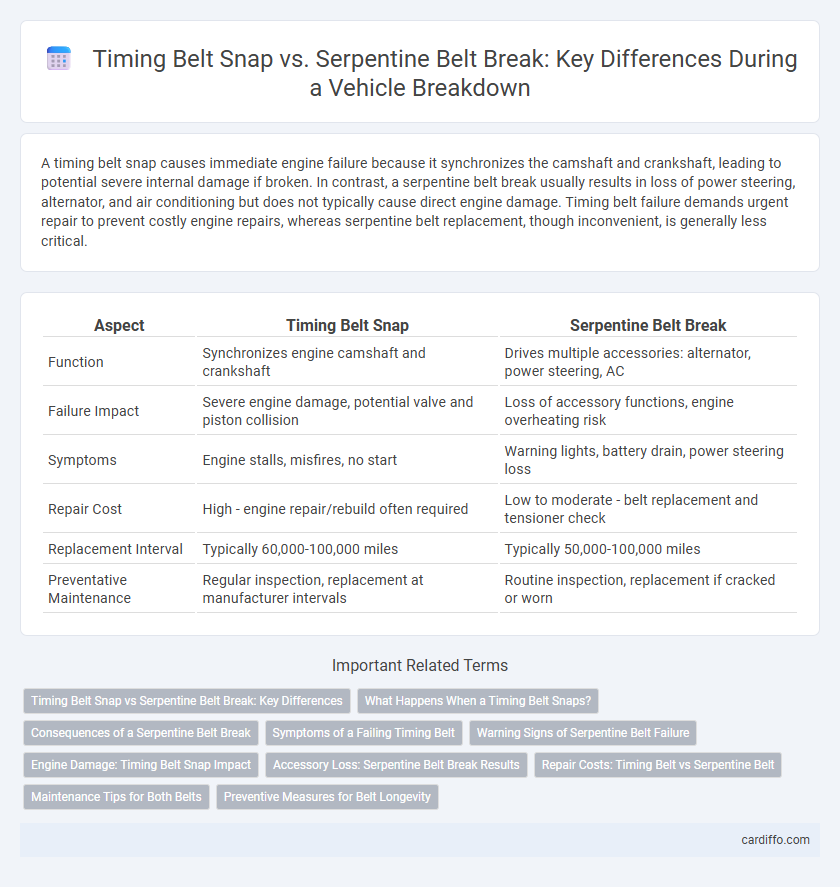A timing belt snap causes immediate engine failure because it synchronizes the camshaft and crankshaft, leading to potential severe internal damage if broken. In contrast, a serpentine belt break usually results in loss of power steering, alternator, and air conditioning but does not typically cause direct engine damage. Timing belt failure demands urgent repair to prevent costly engine repairs, whereas serpentine belt replacement, though inconvenient, is generally less critical.
Table of Comparison
| Aspect | Timing Belt Snap | Serpentine Belt Break |
|---|---|---|
| Function | Synchronizes engine camshaft and crankshaft | Drives multiple accessories: alternator, power steering, AC |
| Failure Impact | Severe engine damage, potential valve and piston collision | Loss of accessory functions, engine overheating risk |
| Symptoms | Engine stalls, misfires, no start | Warning lights, battery drain, power steering loss |
| Repair Cost | High - engine repair/rebuild often required | Low to moderate - belt replacement and tensioner check |
| Replacement Interval | Typically 60,000-100,000 miles | Typically 50,000-100,000 miles |
| Preventative Maintenance | Regular inspection, replacement at manufacturer intervals | Routine inspection, replacement if cracked or worn |
Timing Belt Snap vs Serpentine Belt Break: Key Differences
Timing belt snap typically causes severe engine damage because it controls the camshaft and valves, leading to costly repairs, whereas serpentine belt break usually affects accessory components like the alternator, power steering, and air conditioning, resulting in less critical but inconvenient failures. Timing belts often require replacement every 60,000 to 100,000 miles to prevent snapping, while serpentine belts generally last around 50,000 to 100,000 miles and are easier and less expensive to replace. Recognizing the symptoms of timing belt failure, such as engine misfires or inability to start, versus serpentine belt issues like loss of power steering or battery charging, helps in timely diagnosis and preventive maintenance.
What Happens When a Timing Belt Snaps?
When a timing belt snaps, the engine's camshaft and crankshaft lose synchronization, causing valves to collide with pistons and result in severe internal engine damage. Unlike serpentine belts that drive accessories like the alternator and power steering, a timing belt failure can lead to complete engine failure requiring major repairs or engine replacement. Immediate engine shutdown is crucial to prevent costly mechanical damage from this critical timing belt break.
Consequences of a Serpentine Belt Break
A serpentine belt break can lead to the immediate loss of critical vehicle functions such as power steering, alternator operation, and air conditioning, potentially causing unsafe driving conditions. Without the serpentine belt, the battery may rapidly drain due to the alternator's failure to charge, increasing the risk of a complete engine shutdown. This can result in costly repairs and towing, emphasizing the importance of regular belt inspections to prevent unexpected breakdowns.
Symptoms of a Failing Timing Belt
A failing timing belt often causes engine misfires, rough idling, and difficulty starting due to disrupted synchronization between the crankshaft and camshaft. Unlike a serpentine belt break, timing belt failure can lead to severe engine damage as valves may collide with pistons. Early symptoms include unusual engine noise, vibrations, and oil leakage near the belt cover, signaling the need for immediate inspection.
Warning Signs of Serpentine Belt Failure
Warning signs of serpentine belt failure include squealing noises from the engine, visible cracks or fraying on the belt surface, and loss of power steering or air conditioning. Unlike a timing belt snap, which often causes severe engine damage, a serpentine belt break typically leads to accessory failures but can leave the engine running. Early detection through these signs helps prevent unexpected breakdowns and costly repairs.
Engine Damage: Timing Belt Snap Impact
A timing belt snap can cause severe engine damage due to its critical role in synchronizing the camshaft and crankshaft, often leading to bent valves or piston contact in interference engines. In contrast, a serpentine belt break typically results in loss of accessory functions like power steering or alternator operation but rarely causes internal engine damage. Prompt replacement of timing belts at manufacturer-recommended intervals prevents catastrophic engine failures associated with timing belt snapping.
Accessory Loss: Serpentine Belt Break Results
A serpentine belt break results in immediate accessory loss, causing the alternator, power steering pump, water pump, and air conditioning compressor to stop functioning simultaneously. This leads to rapid battery drainage, overheating due to coolant circulation failure, and loss of power steering assistance, which can compromise vehicle control. In contrast, a timing belt snap primarily affects engine timing but does not directly stop accessory components from operating.
Repair Costs: Timing Belt vs Serpentine Belt
Timing belt replacement typically involves higher repair costs ranging from $500 to $1,000 due to labor-intensive procedures and the need for precise engine timing adjustments. Serpentine belt repair is generally less expensive, often between $100 and $300, as it is easier to access and replace without extensive engine disassembly. Timing belt failure can lead to costly engine damage, significantly increasing overall repair expenses compared to serpentine belt breakage.
Maintenance Tips for Both Belts
Regular inspection of timing belts and serpentine belts is crucial, as timing belts typically require replacement every 60,000 to 100,000 miles, whereas serpentine belts may last 50,000 to 70,000 miles depending on vehicle conditions. Look for signs of wear such as cracks, fraying, and glazing, and listen for squealing noises indicating belt slippage or damage. Proper tension adjustment and timely replacement based on manufacturer recommendations prevent engine damage and ensure the longevity of both belts.
Preventive Measures for Belt Longevity
Regularly inspecting the timing belt and serpentine belt for wear and tension helps prevent unexpected breakdowns and extends belt longevity. Using manufacturer-recommended replacement intervals and high-quality belts reduces the risk of sudden snapping or breaking. Maintaining proper engine fluid levels and avoiding exposure to extreme heat also enhance belt durability and performance.
Timing belt snap vs serpentine belt break Infographic

 cardiffo.com
cardiffo.com